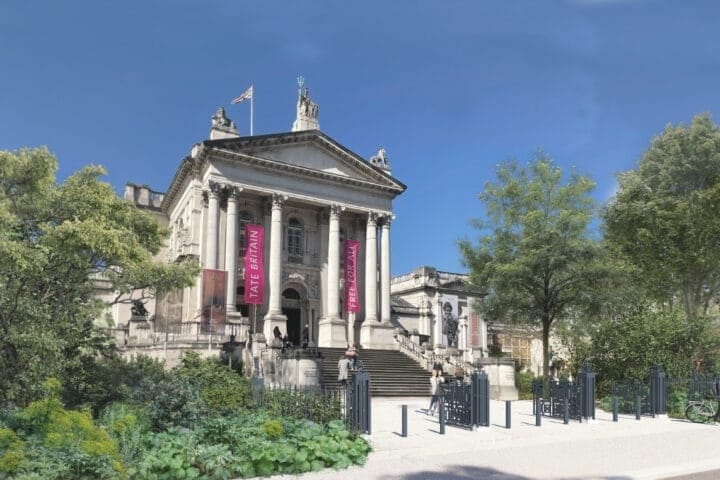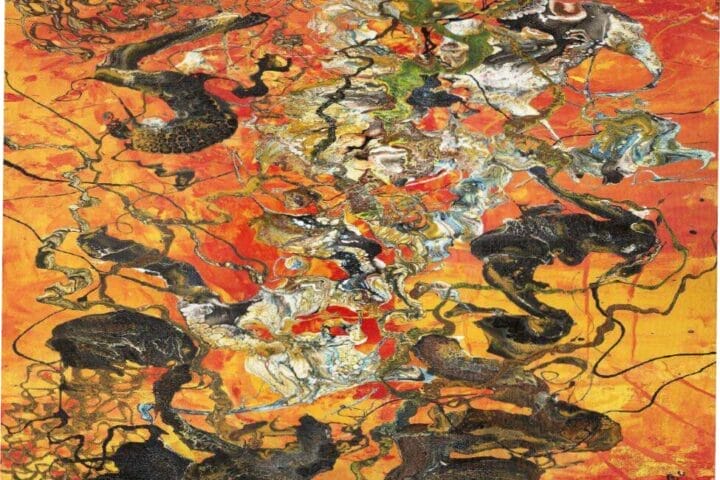New York – Pace is pleased to present Mika Tajima: Energetics, an exhibition of new work by Mika Tajima, at its 540 West 25th Street gallery in New York. On view from January 12 to February 24, 2024, this presentation—bringing together sculptural, textile, and evolving sensorial works—will be the artist’s first exhibition with Pace in New York since she joined the gallery’s program in 2022 and her first solo show in the city in eight years.
Through her multidisciplinary practice spanning performance, sculpture, painting, and installation, Tajima takes up questions of identity and agency in a world increasingly influenced and mitigated by technology. Drawing on various points of reference—including quantum mechanics, Hannah Arendt’s writings on the nature of freedom,
and Catherine Malabou’s notion of plasticity and the body as a vexed relation—the artist imbues her work across mediums with scientific and philosophical import. At the center of Tajima’s practice are her investigations of the ways that different digital and aesthetic technologies manifest as intertwined material, perceptual, and psychic experiences.
Her upcoming exhibition at Pace’s New York gallery takes its title from a segment of physics focused on flows and transformations of energy. Enactments of glowing, burning, blooming, and dying will recur across the gallery space, which, in Tajima’s hands, becomes a stage for spiritual and physical transfigurations, traversing digital and ancient temporalities. The acute shifts in the sizes of the works in the show—in relation to human scale—draw attention to our staggeringly infinitesimal existence in the context of geologic and technological time. With her new works, the artist invites questions of what it means to be an individual within this deep time continuum and, in this contemporary moment, amid the inexorable rise of big data.
Upon entering the gallery, visitors will first experience a scent—which incorporates various ingredients used in ancient Mesopotamian divination practices—emitted from a pyramidal incense sculpture in Tajima’s exhibition. Initiating viewers into the presentation, this ambient olfactory element serves to open the mind and to remind one of existence through the senses.
Anchoring the show are new, large-scale textile paintings from the artist’s ongoing Negative Entropy series. For this body of work, the artist has worked with neurosurgeons specializing in repairing the brain through energetic stimulation and activation. Auditory maps of the brain’s activity are translated into visual representations of sound waves (spectrograms) to which Tajima assigns colors. The latest Negative Entropy compositions—produced in collaboration with an experimental textile lab in the Netherlands—are rendered at an entirely new, expansive scale.
As such, these woven spectrograms, forged from virtually imperceptible records of brain activity, speak to the expansiveness of human potential.
Tajima will also present Sense Object (January 1, 2023, United States) as part of Energetics—a portrait of the national sentiment in the United States on January 1, 2023, compressed within a 5d memory crystal. To create this work, the artist collected data from social media on that day, analyzing the sentiments of text-based posts by American users. Made with optoelectronics technology, the massive amount of data is represented as 24 small squares within a cloud image and inscribed into a tiny disc-shaped optical crystal, which balances atop rose quartz. Captured and locked away forever, the data laser etched within the image of the cloud becomes a memorial of sorts, an ode to the abstract, intangible nature of our digital selves.
Three rose quartz sculptures from Tajima’s Pranayama series, a body of work in which the artist has pierced wood or marble surfaces with bronze nozzles cast from real Jacuzzi jets, will be included in the exhibition as well. The locations of punctures in the stones are loosely based on diagrams of bodily pressure points for acupuncture treatment, a traditional wellness technique used to control and direct unknowable life force. With her new rose quartz Pranayama sculptures, Tajima taps into the material’s associations with new age beliefs and aesthetics as well as its ability to produce electrical reactions. Meditating on mysterious flows and releases of energy in bodies, objects, and spaces, these practices that expose interiority and systematize abstract life functions are analogous to technology’s imperative to understand, regulate, and shape human activity.
New sculptural works that incorporate live flowers also explore these ideas of life energy and breath. Transfused with UV fluorescence, the flowers will glow in the exhibition, emitting light as they die. For Tajima, the ephemeral and performative dimensions of these works reflect the constantly fluctuating state of the natural, built, and digital worlds that we inhabit and create.
Following her exhibition with Pace, Tajima will present Super Natural, a solo exhibition at the Hill Art Foundation in New York, in May 2024. Her work will also be included in Breath(e): Towards Climate and Social Justice, the Hammer Museum’s forthcoming Pacific Standard Time exhibition in Los Angeles, co-curated by Mika Yoshitake and Glenn Kaino and opening in September 2024.
Mika Tajima: Energetics is realized with support from Professor Peter Kazansky (University of Southampton), Dr. Amanda Carpenter, Textiel Lab, TAE Technologies, Seishoji Temple, Obayashi Corp., and Brooklyn Research.
Mika Tajima (b. 1975, Los Angeles) is an artist whose practice materializes techniques developed to shape the physicality, productivity, and desires of the human body. Her sculptures, paintings, videos, and installations focus on the embodied experience of ortho-architectonic control and computational life. From architectural systems to ergonomic design to psychographic data, Tajima’s works operate in the space between the immaterial and the tangible to create heightened encounters that target the senses and emotions of the viewer, underlining the dynamics of control and agency.
Tajima earned a BA in Fine Arts and East Asian Studies from Bryn Mawr College, Pennsylvania (1997), and an MFA from Columbia University, School of the Arts, New York (2003). Recent solo exhibitions of her work include Appear, Dazaifu Tenmangu, Dazaifu, Japan (2022); Spectral, Taro Nasu, Tokyo, Japan (2022); Mika Tajima: You Must Be Free, Kayne Griffin, Los Angeles (2022). Recent group exhibitions of including her work include Dirty Protests, The Hammer Museum, Los Angeles (2019); Programmed: Rules, Codes, and Choreographies in Art, 1965–2018, Whitney Museum of American Art, New York (2018); COLORI, Castello di Rivoli and GAM, Torino, Italy (2017); All Watched Over by Machines of Loving Grace, Palais de Tokyo, Paris, France (2017); and Mika Tajima: Meridian (Gold), Sculpture Center, New York (2016). Her work resides in numerous public collections worldwide including the Los Angeles County Museum of Art, California; Hammer Museum, Los Angeles, California; San Francisco Museum of Modern Art, California; Dallas Museum of Art, Texas; Albright-Knox Art Gallery, Buffalo, New York; and the Hirschhorn Museum and Sculpture Garden, Washington, D.C, among others.
Pace is a leading international art gallery representing some of the most influential contemporary artists and estates from the past century, holding decades-long relationships with Alexander Calder, Jean Dubuffet, Barbara Hepworth, Agnes Martin, Louise Nevelson, and Mark Rothko. Pace enjoys a unique U.S. heritage spanning East and West coasts through its early support of artists central to the Abstract Expressionist and Light and Space movements.
Since its founding by Arne Glimcher in 1960, Pace has developed a distinguished legacy as an artist-first gallery that mounts seminal historical and contemporary exhibitions. Under the current leadership of CEO Marc Glimcher, Pace continues to support its artists and share their visionary work with audiences worldwide by remaining at the forefront of innovation. Now in its seventh decade, the gallery advances its mission through a robust global program— comprising exhibitions, artist projects, public installations, institutional collaborations, performances, and interdisciplinary projects. Pace has a legacy in art bookmaking and has published over five hundred titles in close collaboration with artists, with a focus on original scholarship and on introducing new voices to the art historical canon.
Today, Pace has seven locations worldwide, including European footholds in London and Geneva as well as Berlin, where the gallery established an office in 2023. Pace maintains two galleries in New York—its headquarters at 540 West 25th Street, which welcomed almost 120,000 visitors and programmed 20 shows in its first six months, and an adjacent 8,000 sq. ft. exhibition space at 510 West 25th Street. Pace’s long and pioneering history in California includes a gallery in Palo Alto, which was open from 2016 to 2022. Pace’s engagement with Silicon Valley’s technology industry has had a lasting impact on the gallery at a global level, accelerating its initiatives connecting art and technology as well as its work with experiential artists. Pace consolidated its West Coast activity through its flagship in Los Angeles, which opened in 2022. Pace was one of the first international galleries to establish outposts in Asia, where it operates permanent gallery spaces in Hong Kong and Seoul, along with an office and viewing room in Beijing. In spring 2024, Pace will open its first gallery space in Japan in Tokyo’s new Azabudai Hills development.









